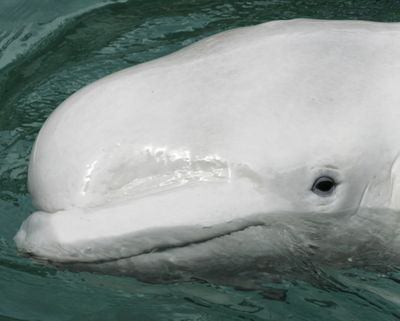Alaska’s beluga whales endangered
Bush administration rejects Gov. Palin’s claims

The Bush administration on Friday declared a small, isolated population of beluga whales in Alaska’s Cook Inlet as endangered species, rejecting claims from Alaska Gov. Sarah Palin that these small, white whales were on their way to recovery.
The National Marine Fisheries Service decided to extend federal protections to these whales near Anchorage after their numbers declined nearly 50 percent in the 1990s and the whales failed to rebound despite a decade-long program to revive the species.
“In spite of protections already in place, Cook Inlet beluga whales are not recovering,” said James Balsiger, acting director of the National Marine Fisheries Service.
As a practical matter, the new protections mean that new offshore oil drilling, a new bridge and other industrial activities that involve federal dollars or scrutiny will have to show that they will not harm the estimated 375 beluga whales that remain in local waters.
The decision came after Palin won a six-month postponement of the decision last year, stating that she and state scientists believe the endangered status was “unwarranted” and that “we’ve actually seen the beginnings of an increase in their population.”
Palin was especially concerned, she said, that “an unnecessary federal listing and designation of critical habitat would do serious long-term damage to the vibrant economy of the Cook Inlet area.”
That delay gave federal biologists another season to conduct aerial surveys, which confirmed that the population remained at 375 and showed no sign of increase. Estimates have ranged from a high of 653 belugas in 1994 to a low of 278 in 2005.
Whale biologists have not determined why the population has not rebounded since a federal plan curtailed the beluga hunt by Alaska native tribes in 1999, said Barbara Mahoney, a fisheries service biologist in Anchorage. Subsistence hunters have taken only five Cook Inlet whales since 1999 and none in the past two years.
No hunting will be permitted through 2012, a ban that will be extended if the population falls below 350 whales, she said.
The Cook Inlet beluga population, one of five populations recognized in U.S. waters, is the most urban. More than half of Alaska’s human population lives in Anchorage and surrounding areas, releasing minimally treated municipal sewage and polluted urban runoff into the inlet.
Other potential stresses on the beluga population are offshore oil and gas development, two busy ports with ship traffic, an active salmon gill net fishery and predation from killer whales, federal scientists said.
“We have a dozen oil rigs in the inlet now and municipal waste that gets primary treatment only,” Mahoney said. More offshore oil development is under consideration for Cook Inlet, which lies between the Alaska and Kenai peninsulas.
Federal protections came in response to a petition for the Center for Biological Diversity, a nonprofit conservation group, and a lawsuit by five conservation groups last summer over what they called “illegal” delays.
A spokeswoman for the governor said her office will issue a comment on the federal protections later.